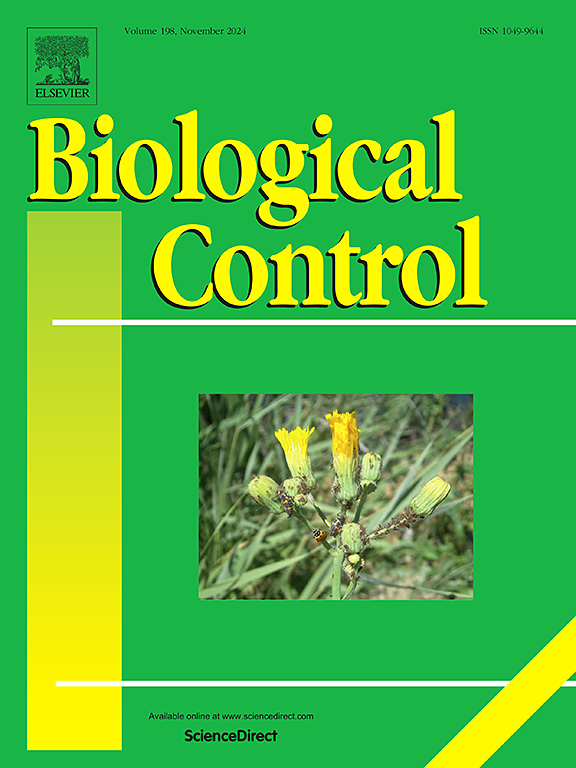V型:一种性别连锁的杂交菌株,具有不同程度的优势性,可抵抗三种单胞Cydia pomonella颗粒病毒
IF 3.4
2区 农林科学
Q2 BIOTECHNOLOGY & APPLIED MICROBIOLOGY
引用次数: 0
摘要
众所周知,冷蛾(Cydia pomonella)对许多(生物)杀虫剂具有抗性,包括Cydia pomonella颗粒病毒(CpGV)。在欧洲市场上可获得的多种分离株中,已知有两株具有选择性耐药性:对CpGV-M的I型和对E群(CpGV-S或-R5)的II或III型。2019年,一项监测计划显示,三种野生昆虫种群对三种主要使用的病毒分离株(CpGV-M、-R5和-V15)的易感性降低。在这种情况下,我们的目标是描述这种被称为V型的新型抗性,并确定其遗传模式和优势程度,并调查它是否以及如何与先前描述的抗性机制不同。我们收集了一个先前被确定为多抗性的群体,在13代中分离并选择了CpGV-M、-R5或无病毒的几个品系。生物测定结果表明,该菌株对CpGV-M、-R5和-V15具有较高的抗性,且具有交叉抗性。个体杂交试验表明,v型对CpGV-M和CpGV-R的抗性遗传模式不同,CpGV-M的抗性表现为显性z连锁,而CpGV-R的抗性表现为隐性连锁,但仍为z连锁。总之,V型是一种CpGV-V15无法克服的新型抗性,具有独特的遗传模式。需要进一步的研究来了解对每种分离物的抗性之间的关系,并适应未来的有害生物管理策略。本文章由计算机程序翻译,如有差异,请以英文原文为准。
Type V: A sex-linked crossed resistance to three Cydia pomonella granulovirus isolates, with different levels of dominance
The codling moth (Cydia pomonella), is known to be resistant to many (bio)insecticides, including the Cydia pomonella granulovirus (CpGV). Of the multiple isolates available on the European market, two are already known to have selected resistance: Type I to CpGV-M and type II or III to group E (CpGV-S or -R5). In 2019, a monitoring program revealed three wild populations of insects with reduced susceptibility to the three main used virus isolates (CpGV-M, -R5 and -V15). In this context, our aim was to characterise this new type of resistance, referred to as Type V, and to determine its inheritance pattern and degree of dominance, and to investigate whether and how it differs from previously described resistance mechanisms.
We collected a population previously identified as multiresistant from which several lines were isolated and selected during 13 generations with either CpGV-M, -R5 or no virus. Bioassays clearly showed high levels of resistance to CpGV-M, -R5 and -V15, as well as cross-resistance between the three isolates. Individual crossing experiments showed different inheritance modes for resistance to CpGV-M and CpGV-R in type V. Resistance to CpGV-M appeared dominant Z-linked as in type I, while it was more likely recessive, but still Z-linked for resistance to CpGV-R. Altogether, Type V is a novel type of resistance that cannot be overcome by CpGV-V15, and marked by a distinct inheritance pattern. Further research is needed to understand the relationship between resistance to each isolate, and adapt the future pest management strategies.
求助全文
通过发布文献求助,成功后即可免费获取论文全文。
去求助
来源期刊

Biological Control
生物-昆虫学
CiteScore
7.40
自引率
7.10%
发文量
220
审稿时长
63 days
期刊介绍:
Biological control is an environmentally sound and effective means of reducing or mitigating pests and pest effects through the use of natural enemies. The aim of Biological Control is to promote this science and technology through publication of original research articles and reviews of research and theory. The journal devotes a section to reports on biotechnologies dealing with the elucidation and use of genes or gene products for the enhancement of biological control agents.
The journal encompasses biological control of viral, microbial, nematode, insect, mite, weed, and vertebrate pests in agriculture, aquatic, forest, natural resource, stored product, and urban environments. Biological control of arthropod pests of human and domestic animals is also included. Ecological, molecular, and biotechnological approaches to the understanding of biological control are welcome.
 求助内容:
求助内容: 应助结果提醒方式:
应助结果提醒方式:


